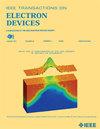Theoretical Investigation of Self-Heating Effect on AC Quantum Transport in p-Type FinFET in THz Frequency by AC Non-Equilibrium Green’s Function Method With Phonon Scattering
IF 2.9
2区 工程技术
Q2 ENGINEERING, ELECTRICAL & ELECTRONIC
引用次数: 0
Abstract
In this article, a multiphysics simulation is performed to investigate the self-heating effect (SHE) on p-type FinFET ac quantum transport by introducing the temperature distribution obtained from dc quantum transport and heat conduction simulation into the ac non-equilibrium Green’s function with consideration of phonon scattering. The complicated valence band and hole-phonon scattering are captured by employing three-band求助全文
约1分钟内获得全文
求助全文
来源期刊

IEEE Transactions on Electron Devices
工程技术-工程:电子与电气
CiteScore
5.80
自引率
16.10%
发文量
937
审稿时长
3.8 months
期刊介绍:
IEEE Transactions on Electron Devices publishes original and significant contributions relating to the theory, modeling, design, performance and reliability of electron and ion integrated circuit devices and interconnects, involving insulators, metals, organic materials, micro-plasmas, semiconductors, quantum-effect structures, vacuum devices, and emerging materials with applications in bioelectronics, biomedical electronics, computation, communications, displays, microelectromechanics, imaging, micro-actuators, nanoelectronics, optoelectronics, photovoltaics, power ICs and micro-sensors. Tutorial and review papers on these subjects are also published and occasional special issues appear to present a collection of papers which treat particular areas in more depth and breadth.
 求助内容:
求助内容: 应助结果提醒方式:
应助结果提醒方式:


